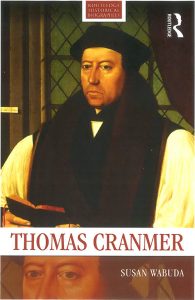Thomas Cranmer, the Archbishop of Canterbury from 1533 to 1556, is well known for his role in helping build the case for the annulment of King Henry VIII’s marriage to Katherine of Aragon, which was one of the causes of the separation of the Church of England from union with the Holy See.

But in Thomas Cranmer (Routledge 2017), a new biography by Susan Wabuda, Ph.D., associate professor of history, fresh new details about Cranmer’s private life reveal a man who was more complicated than his public persona might have presented.
“His whole motivation was about saving souls. Many people know about the emergence of Martin Luther; Cranmer was part of that. He, too, was disturbed by the things that Luther was saying,” Wabuda said.
“So rather than come into any immediate conclusions, he sat down with all the books, read all the material that Luther had read, went back to the early fathers of the church, and made up his own mind.”
In the course of researching the book, Wabuda discovered definitive proof of Cranmer’s ordination, in 1515. This is important, she said, because it calls into question many of the early stories that were told about him. One story posited that he left a fellowship at Jesus College at Cambridge in order to get married, and when his wife died in childbirth, he came back.
“But that isn’t what happened. He seemed to have gotten married as an undergraduate, and we don’t know why. Whether he’d made a mistake, we just don’t know. But it seems clear he never intended to have a career in the church,” she said.
Wabuda called him a man of many contradictions, some of which she ultimately was not able to reconcile. He was known to be an inquisitive, curious, and driven man who cared about saving the souls of the faithful, and he supported William Tyndale’s efforts to translate the Bible into English and make it available for ordinary people to read.
He also brought to his position the talents of his tight-knit family, including a brother and sister, with whom he worked very closely with on matters such as the Eucharist, clerical celibacy, the role of images in places of worship, and the veneration of saints.
 “They worked very hard to establish a Protestant Church in England. They did this together. It was not just one man fighting on his own; he had the backing of a loving family behind him,” she said.
“They worked very hard to establish a Protestant Church in England. They did this together. It was not just one man fighting on his own; he had the backing of a loving family behind him,” she said.
However, many of his efforts to reform the Church of England were thwarted, Wabuda said. Cranmer was never able to persuade Henry to align England with the Lutherans, and he could not persuade the king to allow the English people to worship in English. Not until the reign of Henry’s son, Edward VI (1547-1553), could Cranmer for the first time release all of the services of worship in English in the Book of Common Prayer. But King Edward died unexpectedly in July 1553. Cranmer’s life work was in danger of being discarded forever when he was executed by Queen Mary I.
“Cranmer is a really interesting figure to try to understand because the kinds of questions he wrestled with, and the problems he faced, are questions all of us are facing all the time. He came to his own solutions, and it’s absolutely reassuring to know that other people in the past had challenges that they rose to address,” Wabuda said.
In the end, his biggest challenge turned out to be his last—he was accused of heresy by Queen Mary I, the daughter of Katherine of Aragon. He was forced to retract everything he had ever taught to save his life, or stand up for what he believed in and face execution. After briefly backpedaling, he was burned at the stake in 1556.
“When he realized that no matter how many apologies he made they were going to kill him anyway, he refused any longer to deny what he had taught the English people as archbishop. He said that he had done wrong by signing retractions and apologies merely to save his own life. Rather, he decided to defend what he had taught, and to prove it, he put his right hand in the flames first, and held it there until he died,” Wabuda said.
His action, she said, helped many people believe what he taught was of value. When Elizabeth I became queen following Mary’s death in 1558, the Book of Common Prayer once again became the service book for the English Church.
“There were many people who thought he was a martyr. I conclude my book by saying ‘Well, he was, but he was a reluctant one.’”

